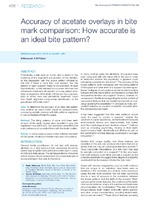| dc.contributor.author | Mohamed, Nadia | |
| dc.contributor.author | Phillips, V.M. | |
| dc.date.accessioned | 2018-01-19T12:41:43Z | |
| dc.date.available | 2018-01-19T12:41:43Z | |
| dc.date.issued | 2017 | |
| dc.identifier.citation | Mohamed, N. & Phillips, V.M. (2017). Accuracy of acetate overlays in bite mark comparison: How accurate is an ideal bite pattern? South African Dental Journal, 72(10): 456 - 461 | en_US |
| dc.identifier.issn | 0011-8516 | |
| dc.identifier.uri | http://dx.doi.org/10.17159/2519-0105/2017/v72no10a2 | |
| dc.identifier.uri | http://hdl.handle.net/10566/3404 | |
| dc.description.abstract | Forensically, a bite mark on human skin is reliant on the
matching of the alignment and position of the dentition
of the perpetrator with the bruise pattern inflicted by
the bite. If there is more than one suspect, the bite
pattern of each suspect needs to be analysed. At least
hypothetically, a bite delivered by a person who has had
orthodontic treatment will result in a bruise pattern of an
ideal arrangement of the teeth. If there are two suspects,
both of whom have had orthodontic treatment, could
that “ideal” alignment compromise identification of the
perpetrator of the bite mark? | en_US |
| dc.language.iso | en | en_US |
| dc.publisher | South African Dental Association | en_US |
| dc.rights | This file may be freely used for educational uses. No commercial reproduction or distribution of this file is permitted without written permission of the South African Dental Association (SADA). Note that the SADA retains all intellectual property rights in the article. | |
| dc.subject | Bite pattern | en_US |
| dc.subject | Dentistry | en_US |
| dc.subject | Orthodontic treatment | en_US |
| dc.subject | Plaster | en_US |
| dc.subject | Forensics | en_US |
| dc.title | Accuracy of acetate overlays in bite mark comparison: How accurate is an ideal bite pattern? | en_US |
| dc.type | Article | en_US |
| dc.privacy.showsubmitter | FALSE | |
| dc.status.ispeerreviewed | TRUE | |

